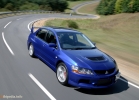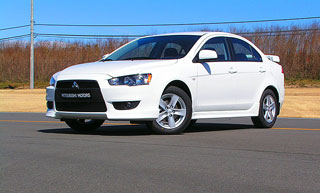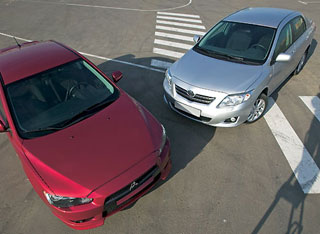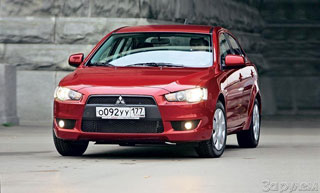Test drive Mitsubishi Lancer Evolution IX 2005 - 2007 sedan
Mitsubishi Lancer Evolution Car Review
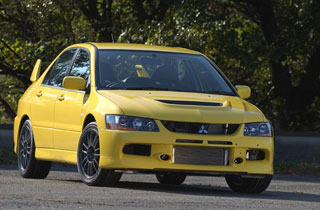 New Lancer Evolution - Mitsubishi Cornial Stone
New Lancer Evolution - Mitsubishi Cornial Stone Mitsubishi has repeatedly announced that at present and henceforth, it makes the main bet on two types of cars. These are, firstly, Sport-DNA cars, the typical representative of which is the Lancer Evolution model (or, as the Japanese loves it, Lanevo). And, secondly, the SUV-DNA category, and above all, the Pajero lineup. Currently, it is supposed to be allegedly all technical improvements that were applied to Lancer Evolution in preparing it to participate in the world rally championship (WRC) will become affordable to owners of the mass version of this car. This statement applies to the Pajero family, which, as you know, participate in the Paris Dakar rally.
In other words, Mitsubishi, which still cannot recover from the shocks of recent years, seeks to return the trust of the broad circles of customers to its serial cars as quickly as possible. At the same time, the circumstances are such that the slowdown in the evolution of the sports machine, which is the Lancer Evolution car, would make the audience doubt the seriousness of intentions declared by the company. How else? I chose an evolution for the car - work on it without turning your hands!
Therefore, no one was surprised that the company had already hastened to officially announce the creation of the Lancer Evolution machine at number IX. Although it would be more correct to see in it so far only the prototype of the new model. However, this prototype has already managed to light up in Germany at the Avurging Avurging Autodrom, which is considered Mecca of modern automakers. Imagine: take -off, jump, fall - you can’t call the conditions on the highway with light ones. The length of the site is northern train 20.8 km per circle. Winter is coming (I describe the events of mid -October) - the time when, as you know, the track is decommissioned. Maybe that's why the ring has an incredible whirlwind, among which the labels of many famous companies flash. Just grinding in the eyes! And among this diversity, the Lancer Evolution IX, with a naked radiator, suddenly appears on all sides, cutting one circle after another without stopping.
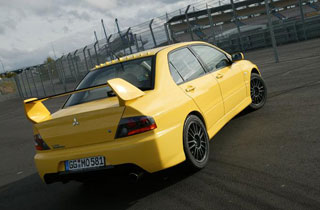 There are only three diamonds ahead
There are only three diamonds ahead At first glance, the appearance of the new Lanevo is not particularly different from its predecessor: the same design as Lanevo VIII MR. And if you look more closely? Well, of course, all small details that somehow affect the aerodynamic characteristics of the machine look different. The car threw off the previous mask, on which the influence of the chief designer Daimler Olivier Bure was clearly visible. Such a layout of the front lining is so everywhere and is called - a mask of a storm. Now, the developers have returned to a simpler solution: only three diamonds-fire and that's it! Or not, not entirely because because of this the coefficient of air resistance decreased. But how many copies are broken about this! Everyone unanimously claimed: the car was born for the world of rally and racing, the previous grille with a basement worsens the circulation of air and, as a result, interferes with the cooling of the engine! Of course, it was possible to walk on this occasion in the sense that, they say, where Mr. Bure had ears, but it is better to lower it.
What else can be noted in the front of is the inserted bumper, more precisely, how this bumper copes with vortex air flows, usually formed under the bottom of the body. Another innovation is a slot, which at first glance may seem a braking element, but is actually an air intake channel to cool the two air ducts of the engine, located on both sides of it. And what has changed in the back of the car? Well, firstly, anti-wing. And the bumper now has the shape of a diffuser. All these aerodynamic tricks serve only one goal: to cope with the lifting force arising under the influence of oncoming air flows.
If we compare the aerodynamics of two cars (the new Lanevo and its predecessor Lanevo VIII MR) in numerical indicators, the situation is this. The lifting coefficient of the front of the Lancer Evolution VIII MR is 0.07, and in IX it is 0.03, that is, it decreased more than half. But the back of the car had previously had a zero lifting moment, and now it generally acquired a negative value. In other words, the oncoming flow of air presses the body to the ground. And this, in turn, means that at ultra -high speed there is no bouncer effect when passing irregularities on the road, there is no secondary departure of the car at the bend. And I really felt this aerodynamic highlight of the new car. But I managed to feel her taste
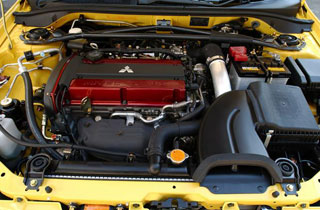 due to the fact that I had the honor to try the Lancer Evolution IX on the Nurebugring test track.
due to the fact that I had the honor to try the Lancer Evolution IX on the Nurebugring test track. Engine with uniformly distributed torque
The most significant changes are observed in the engine. I mean a change in the production scheme of waste gases. For the first time, by car of Mitsubishi, the gas distribution mechanism with automatically changed phases is associated with the operation of the turbocharger system. As a result of changing the shape of the turbocharger chamber (and previously this was used on the racing version to participate in the WRC), it was possible to increase the torque of the engine at low and medium speeds.
In addition, it should be noted that the turbine impeller is not made of aluminum alloy, as before, but from magnesium, which further facilitates the weight of the structure. The achievement time of the maximum possible speed of the air flow decreased by 15%. What happened as a result? The returns from a sharp increase in air pressure are now faster, which also contributes to the fact that the peak of torque occurs at lower revolutions of the motor. The characteristics of the engine, by the way, remained the same: the power is 280 hp. and torque 40.8 kg/m. But the speed of rotation of the crankshaft, at which the motor gives the maximum torque, has decreased. If on the Lancer Evolution VIII MR it amounted to 3500 rpm, then on the Lancer Evolution IX this indicator is already equal to 3,000 revolutions. In addition, the maximum torque is held for quite some time, up to 4000 rpm.! This naturally was reflected in the magnitude of the torque at lower, engine speeds lying in the interval of up to 2500 rpm. Earlier, the Lancer Evolution VIII MR engine has proven itself when working at high speeds. And now, a more uniform distribution of torque is added to this over the entire range of rotation of the crankshaft.
However, adjustable gas distribution (VVT system) controls the valve group only from the inlet. It was decided to refuse to control the valves of the production valves of the exhaust gases. And the reason for this lies in the fact that the upper limit of the engine power of the new model is set at a mark of 280 hp. And if you equip the gas distribution mechanism by adjustable valves and on the release side, this will inevitably lead to an increase in the weight of the cylinder head and increase the cost of the machine as a whole. But personally, I think this: the new Lanevo IX model, equipped with a mechanism for automatic change in the opening of the valves of the intake system, has,
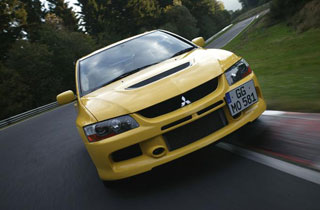 nevertheless, characteristics beyond any expectation. Well, fine, for now you can stop. Of course, ideally, the transfer to the automatic control mode and valves on the release side would play a positive role both in terms of power and in terms of reducing the number of harmful substances in exhaust gases, who argues here. But who said that this would be impossible at the next stage of evolution? Therefore, do not run ahead too much, let's see what will happen next.
nevertheless, characteristics beyond any expectation. Well, fine, for now you can stop. Of course, ideally, the transfer to the automatic control mode and valves on the release side would play a positive role both in terms of power and in terms of reducing the number of harmful substances in exhaust gases, who argues here. But who said that this would be impossible at the next stage of evolution? Therefore, do not run ahead too much, let's see what will happen next. There are high speeds and high stability!
I specifically arranged everything in such a way as to drive a new car immediately after a trip to Lancer Evolution VIII MR. It is believed that this model has already been completely finalized. But, surprisingly, on the course of the body it has a large amplitude of oscillations in a vertical plane. Although it should be noted that the take -off of the car up, and the suspension hits the suspension very smoothly. I am trying to test the car for handling in case of braking at a bend. I establish that if the braking force is valid and the lateral displacement of the machine at the bend increases, a large load falls on the outer front wheel, and the rear internally the wheel turns out to be unloaded. Thus, the machine is in an unstable position.
Lancer Evolution IX controllability is characterized by the fact that the diagonal lead of the machine spent above is largely overcome. Either a role was played by a change in the height of the back of the machine, or this is a consequence of a negative aerodynamic lifting force that occurs in the ass, but the fact remains: the rear wheels do not lose strong contact with the road. And this means that when you begin to slow down on a bend, there is no, you know, such a feeling that the rear wheels are about to break off the rut and go for a walk on their own.
Of course, a strong hitch of the rear wheels with the road to a certain extent is due to the operation of the AYC rotation synchronization system. It has a positive effect in terms of braking efficiency, more precisely, in terms of maintaining the stability of the machine during braking. Try to sharply press the brake at high speed or at a bend - and you will see that thanks to a strong hitch of the rear wheels with the road, under the influence of negative lifting force, the car remains stable from the beginning of the maneuver and until it is completed. And in those areas where Lancer Evolution VIII MR made me get a little nervous, the new Lancer Evolution IX continued to rely equally on all four wheels. And this means that you can fearlessly and sharply put pressure on the brake where it is necessary.
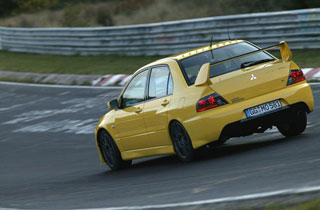 Now regarding the difference between the old and the new engine. As I have already noted, the peak of torque is shifted towards small and medium revolutions. The most characteristic in this regard was the riding. On the Hacoca highway, I specifically tried to squeeze the gas pedal in the fifth gear. So, while driving the Lancer Evolution VIII MR, I saw that the motor came very close to its critical turnover. At the same time, it was felt that to cross the next, the sixth program was still early. And how did Lanevo IX engine behave? He calmly took switching to increased gear and in this state quickly carried me to the top of the mountain. This is what practical importance is the movement of the peak of torque into the lower engine speed! It turns out, in particular, that in the new machine you can achieve the same effect as on the predecessor, but you can only do this even on one level of transmission.
Now regarding the difference between the old and the new engine. As I have already noted, the peak of torque is shifted towards small and medium revolutions. The most characteristic in this regard was the riding. On the Hacoca highway, I specifically tried to squeeze the gas pedal in the fifth gear. So, while driving the Lancer Evolution VIII MR, I saw that the motor came very close to its critical turnover. At the same time, it was felt that to cross the next, the sixth program was still early. And how did Lanevo IX engine behave? He calmly took switching to increased gear and in this state quickly carried me to the top of the mountain. This is what practical importance is the movement of the peak of torque into the lower engine speed! It turns out, in particular, that in the new machine you can achieve the same effect as on the predecessor, but you can only do this even on one level of transmission. Feel the difference, it is noticeable!
After a dizzying race in a circle, I go to a 2-kilometer straight area. Here on the Lancer Evolution VIII MR, I managed to accelerate to 245 km per hour. However, already when approaching this high -speed mark, the machine loses its acceleration intensity. No, a little wrong: the car seems to stumble on the air, but still the wall, it is felt. And then the air resistance simply hits the car with a car! At the end of the direct segment there is a protective fence, and then a small descent on the left. There, the speed is recorded on which it was possible to reach after the congress from the direct section of the highway.
The front part of the machine during the speed of speed is slightly lifted, which to a certain extent affects stability, especially on ultra -high speed. I feel that before I start to take off over the ground and I can’t keep it from the wound. When approaching the protective fence, the body makes a sharp throw in the longitudinal plane. And I do not dare to curtail and direct the car into the wide open gate of the congress. There is nothing to do, it is necessary to state that the speed I have reached is suitable only for a straightforward movement.
Now I am doing the same maneuver, but now sitting behind the wheel of the Lancer Evolution IX car. You won’t believe it, but there are no mention described above destabilizing nuances! Before holding on to the ground, the acceleration intensity does not decrease, on the speedometer it is already 255 km/h! From all over, I fly into the open gates of the side congress and now please: below 260! And nothing but surprise! Well, let's say you should throw off 15 kilometers due to the error of the speedometer readings - at such a speed this error increases significantly. But the point is not in a numerical indicator. Another thing is important: the controllability does not deteriorate, the difference in terms of air resistance, too, as they say, is obvious, I myself clearly felt it! Someone may notice that riding on Japanese roads is not at all like a nourburgering race. I agree that in Japan this difference between the two Lancer Evolution of different generations is unlikely to notice. But I can definitely say: the evolution of the machine is noticeable! Now I'm looking forward to when I can meet with her again. But already in a modified form. And in Japan.
A source: CarView.co.jp





